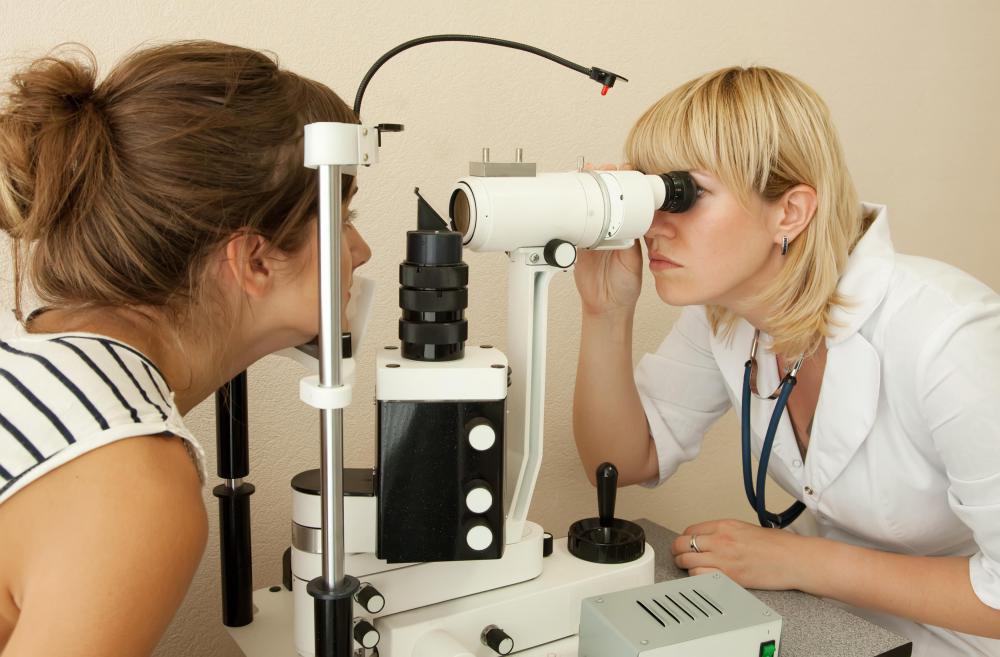At WiseGEEK, we're committed to delivering accurate, trustworthy information. Our expert-authored content is rigorously fact-checked and sourced from credible authorities. Discover how we uphold the highest standards in providing you with reliable knowledge.
What Is Diabetic Dermopathy?
Diabetic dermopathy is a skin condition characterized by scaly, indented patches of skin that occur on the thighs and shins and typically have a rounded or oval shape. The condition is sometimes also called “shin spots.” One of the more severe forms is called eruptive xanthoma, and usually presents as yellow raised pustules that can cover the legs, arms, and other parts of the body. Like the standard spots these can be unsightly, but they aren’t usually problematic from a medical perspective. At least in this respect, they’re one of the more benign side effects of diabetes, but diabetics who notice any sort of skin lesion should usually get prompt care, particularly if the lesions grow or multiply quickly since this can be a sign of complications or problems elsewhere.
Diabetes Side Effects More Generally

Diabetes, or diabetes mellitus as it’s more formally known, is a disease that impacts the way people process sugar. There are usually three main types. Type One diabetes is a genetic problem that people are usually born with; their pancreases can’t process sugar into insulin the way they should. Type Two diabetes usually sets in later in life, typically as a result of lifestyle choices and diets very high in processed sugar. In these cases, the pancreas more or lets shuts down due to overwork. Gestational diabetes affects pregnant women and causes them to temporarily have a problem processing sugar, though in nearly all cases pancreatic function returns to normal after delivery.

The side effects of all three types are fairly numerous, and in most cases the more involved the condition, the more serious the side effects become. Diabetes that is controlled, usually with medication and regular professional evaluations, is usually pretty stable. Problems are most common when the condition is allowed to run its course and blood sugar spikes out of control for prolonged periods of time. Kidney, eye, and foot problems are some of the more serious issues; more generalized fatigue and skin discoloration and lesions usually fall on the “mild” side of the spectrum in comparison. Dermopathy is the most common of all diabetic skin conditions.
Distinguishing the Condition

This particular condition is distinguished by skin lesions that tend to be flat and either round or oval in shape. In some people, they look similar to age spots. The lesions normally cover a large area because they can be quite numerous. They typically do not itch, sting or burn, and neither do they hurt or become open sores.
Diabetic dermopathy can sometimes be seen in people who do not have diabetes, although this is very uncommon. The presence of more than three skin lesions is almost always limited to people who have received a formal diabetes diagnosis, and is more common in advanced stages; in general, people are more likely to develop these lesions if they are over age 40 or have suffered from diabetes for at least 20 years. Up to 30 percent of diabetics will develop the ailment at some point. It is more common in men than in women as well.
What Causes the Discoloration

The lesions are caused by a type of angiitis, or vascular inflammation, that affects small blood vessels in the skin. It is believed to be closely related to an increase in glycosylated hemoglobin, which can indicate poor control of the body's blood glucose levels. Dermopathy usually occurs when the skin becomes injured. The shins are a vulnerable area for the condition because they do not have a great deal of fat to absorb direct trauma.
Eruptive Xanthoma

One form of diabetic dermopathy is called eruptive xanthoma. It results from uncontrolled diabetes. This disorder creates the sudden eruption on the skin of small, yellowish-orange to reddish-brown papules. These papules might appear on the hands, arms, feet, legs and buttocks, and they develop because of high concentrations of plasma triglycerides. The xanthomas usually disappear as soon as the diabetes is under control.
Treatment Options
There is no truly effective treatment for diabetic dermopathy. The skin lesions’ appearance can sometimes improve with better blood sugar control, though, and certain medications and supplements can also help reduce their noticeability. The use of 15-25 milligrams of chelated zinc daily for several weeks has helped some individuals, for instance. The patches and papules tend to go away by themselves after a few years, but they usually will leave scars behind. As with most medical problems, the disorder can be more easily controlled if it is caught in its early stages.
AS FEATURED ON:
AS FEATURED ON:















Discussion Comments
My doctor also told me there was not any specific treatment for these diabetic dermopathy spots. I had a few of these spots show up on my thighs and wanted to see how I could get rid of them.
If you have diabetes it seems to take longer than most people for these types of things to heal or go away. I tried putting some antibiotic cream on them every day to see if it would help.
Eventually the spots did disappear. I don't know if the cream helped or not, but at least it didn't cause any harm.
My Dad has struggled with diabetes for many years and often has a hard time keeping his blood sugar under control. A few years ago he began noticing these small round spots and his doctor told him they were diabetic dermopathy spots.
He was told there isn't really any kind of treatment for them and that the most important thing was to keep his blood sugar levels low.
It seems like these spots are just another reminder of his diabetes and that he has to be very vigilant about taking his medication and watching his diet.
Post your comments